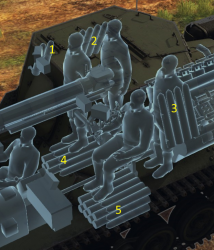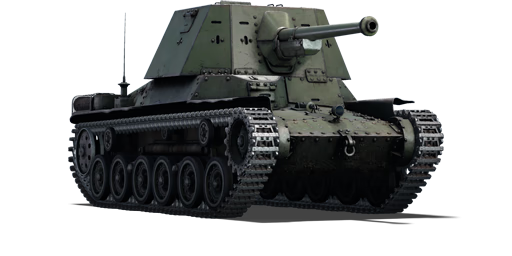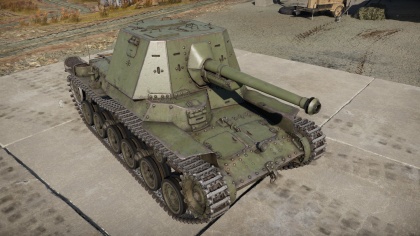Difference between revisions of "Ho-Ni III"
(→Media) |
(→History: Placeholder Dev Blog Entry) |
||
| Line 194: | Line 194: | ||
== History == | == History == | ||
| − | ''Describe the history of the creation and combat usage of the ground vehicle in more detail than in the introduction. If the historical reference turns out to be too big, take it to a separate article, taking a link to an article about the vehicle and adding a block "/ History" (example: <nowiki>https://wiki.warthunder.com/(Vehicle-name)/History</nowiki>) and add a link to it here using the <code>main</code> template. Be sure to reference text and sources by using <code><nowiki><ref></nowiki></code>, as well as adding them at the end of the article.'' | + | <!--''Describe the history of the creation and combat usage of the ground vehicle in more detail than in the introduction. If the historical reference turns out to be too big, take it to a separate article, taking a link to an article about the vehicle and adding a block "/ History" (example: <nowiki>https://wiki.warthunder.com/(Vehicle-name)/History</nowiki>) and add a link to it here using the <code>main</code> template. Be sure to reference text and sources by using <code><nowiki><ref></nowiki></code>, as well as adding them at the end of the article.''--> |
| + | The Type 3 Ho-Ni III is a self-propelled anti-tank artillery gun. The Ho-Ni III was the third of the Japanese ‘tank destroyers’, which Japan developed based on inspiration from the German tanks of this class. This SPG was very similar to the previous models of this series, the Ho-Ni I and Ho-Ni II, but surpassed them in multiple ways, embodying all the very best of each of them. The chassis of the medium Type 97 Chi-Ha Kai tank was used as a base, while the Ho-Ni I and II used a simple, unmodernized version of the Type 97 Chi-Ha. The powerful 75 mm Type 90 field cannon was chosen as a gun. In its design, this was a counterpart of the French 85 mm Schneider cannon (85 mle 1927 Schneider). After a small redesign for installation on the tank, this gun was designated the Type 3. The cannon was installed in an armored non-rotating superstructure which, in contrast to the Ho-Ni I and Ho-Ni II, was fully enclosed on all sides and provided optimal protection for the crew. Additional ammo took the place of the machine gun in the hull, and the SPG’s crew was reduced to four (in comparison to the five of the previous vehicles in this series). | ||
| + | |||
| + | Ho-Ni series SPGs went into production in 1942, and the order to design and produce the upgraded Ho-Ni III was received by the Hitachi firm in the beginning of 1944. Due to a shortage of resources and constant bombings, the Japanese industry was only able to produce roughly 35 Ho-Ni III SPGs before the end of the war. Most of them were distributed among divisions tasked with defending Japan itself, while only a few were sent to areas of active military operations such as Okinawa and the Philippines. No records survive of military clashes between the Ho-Ni III and American tanks. | ||
| + | |||
| + | - From [[wt:en/news/4361-development-type-3-ho-ni-iii-the-japanese-marder-en/|Devblog]] | ||
== Media == | == Media == | ||
Revision as of 13:06, 13 December 2020
Contents
| This page is about the tank destroyer Ho-Ni III. For the preceding vehicle of similar name, see Ho-Ni I. |
Description
The Type 3 Ho-Ni III is a Rank II Japanese tank destroyer
with a battle rating of 2.3 (AB/RB/SB). It was introduced along with the entire Japanese Ground Forces tree in Update 1.65 "Way of the Samurai". It handles and plays very similarly to the Ho-Ni I before it, but has been refined with the addition of more crew, a faster reload time, and most importantly, armour around the gun crew. However, it pays a slight cost of reduced top speed.
General info
Survivability and armour
Having 25 mm of armour coverage around the entire gun crew, the Ho-Ni III no longer needs to fear artillery shrapnel or strafing runs from fighter aircraft. Do note however that it's still vulnerable to bombs, rockets and direct artillery hits! However, if the Ho-Ni III takes a hit, likely to survive with more operational crewmembers, as three of them must be knocked out before the vehicle becomes inoperable.
Another small armour increase is seen on the front of the tank, with the driver and radio station protected with another 10 mm of armour, though with this added strength, it still leaves an undesirable total width of a lacking 35 mm.
Armour type:
- Rolled homogeneous armour
| Armour | Front | Sides | Rear | Roof |
|---|---|---|---|---|
| Hull | 25 mm (12-31°) Front plate 17 mm (80-81°) Front glacis 15 mm (63°) Joint plate 15 mm (37-59°) Lower glacis |
25 mm (40°) Top Left 20 mm (24-27°) Top Right 20 mm Bottom |
17 mm (69°) Top 20 mm (4-58°) Bottom |
12 mm |
| Superstructure | 25 mm (15-16°) Front 25 mm (3-47°) Gun mantlet |
25 mm (24-26°) | 25 mm (10-11°) | 10 mm |
Notes:
- Suspension wheels and tracks are both 15 mm thick.
- Driver's port on the front plate is 10 mm thick.
- An extra 10 mm of armour is plated on top of the bow machine gun area, left from the driver's position.
Mobility
| Game Mode | Max Speed (km/h) | Weight (tons) | Engine power (horsepower) | Power-to-weight ratio (hp/ton) | |||
|---|---|---|---|---|---|---|---|
| Forward | Reverse | Stock | Upgraded | Stock | Upgraded | ||
| Arcade | 44 | 21 | 16.8 | 241 | 324 | 14.35 | 19.29 |
| Realistic | 40 | 19 | 150 | 170 | 8.93 | 10.12 | |
The only drawback of the Ho-Ni III compared to its previous version, is that the tank has a slight decrease in top speed. On flat grass, it reaches a top speed of 32 km/h, compared to the Ho-Ni I's top speed of 36 km/h.
Armaments
Main armament
The Ho-Ni III features a modernized Type 3 75 mm tank gun, based on the Type 90 75 mm field gun as on the previous Ho-Ni I, still being a great cannon, even with a slightly higher battle rating. With the addition of two dedicated loaders in a fully closed casemate, the gun also gets almost a second cut down on its reload time, making it capable of even more destruction.
| 75 mm Type 3 | Turret rotation speed (°/s) | Reloading rate (seconds) | |||||||||||
|---|---|---|---|---|---|---|---|---|---|---|---|---|---|
| Mode | Capacity | Vertical | Horizontal | Stabilizer | Stock | Upgraded | Full | Expert | Aced | Stock | Full | Expert | Aced |
| Arcade | 46 | -10°/+20° | ±10° | N/A | 14.09 | 19.50 | 23.68 | 26.20 | 27.86 | 7.15 | 6.33 | 5.80 | 5.50 |
| Realistic | 9.52 | 11.20 | 13.60 | 15.04 | 16.00 | ||||||||
Ammunition
| Penetration statistics | |||||||
|---|---|---|---|---|---|---|---|
| Ammunition | Type of warhead |
Penetration @ 0° Angle of Attack (mm) | |||||
| 10 m | 100 m | 500 m | 1,000 m | 1,500 m | 2,000 m | ||
| Type 1 APHE | APHE | 103 | 101 | 92 | 82 | 73 | 65 |
| Type 94 HE | HE | 12 | 12 | 12 | 12 | 12 | 12 |
| Shell details | |||||||||
|---|---|---|---|---|---|---|---|---|---|
| Ammunition | Type of warhead |
Velocity (m/s) |
Projectile Mass (kg) |
Fuse delay (m) |
Fuse sensitivity (mm) |
Explosive Mass (TNT equivalent) (g) |
Ricochet | ||
| 0% | 50% | 100% | |||||||
| Type 1 APHE | APHE | 668 | 6.56 | 1.3 | 15 | 84.8 | 47° | 60° | 65° |
| Type 94 HE | HE | 522 | 6.02 | 0.1 | 0.1 | 810 | 79° | 80° | 81° |
| Smoke shell characteristics | ||||||
|---|---|---|---|---|---|---|
| Ammunition | Velocity (m/s) |
Projectile Mass (kg) |
Screen radius (m) |
Screen deploy time (s) |
Screen hold time (s) |
Explosive Mass (TNT equivalent) (g) |
| Type 90 Smoke | 570 | 5.72 | 13 | 5 | 20 | 100 |
Ammo racks

| Full ammo |
1st rack empty |
2nd rack empty |
3rd rack empty |
4th rack empty |
5th rack empty |
Visual discrepancy |
|---|---|---|---|---|---|---|
| 46 | 45 (+1) | 41 (+5) | 37 (+9) | 24 (+22) | 1 (+45) | No |
Turret empty: 37 (+9)
Usage in battles
The Ho-Ni III plays very similar to the Ho-Ni I with the added benefit of two extra crew which cuts down on the reload time for the 75 mm gun.
The starting Japanese player will also be quite accustomed to the handling of the hull, as it still is based on the Chi-Ha. But due to the added weight of the fully enclosed casemate, it is slower compared to its brother Chi-Ha.
With the added benefit of the casemate and crew, the Ho-Ni III sports better survivability, though, most shells will not knock you out in one shot due to having a total of five crew members. The crew isn't out in the open anymore and has sufficient armour from machine-gun fire from both ground & air enemies. Knowing this, you can stand to take more chances of sitting in one location and not have to worry about aircraft making a single pass and taking the vehicle out.
Modules
| Tier | Mobility | Protection | Firepower | |
|---|---|---|---|---|
| I | Tracks | Parts | Horizontal Drive | |
| II | Suspension | Brake System | FPE | Adjustment of Fire |
| III | Filters | Crew Replenishment | Elevation Mechanism | |
| IV | Transmission | Engine | Type 90 Smoke | |
Pros and cons
Pros:
- Effective 75 mm gun with APHE can penetrate all enemies at its rank
- Effective -10° gun depression
- Fully enclosed crew compartment provides better protection from strafing aircraft
- Five man crew, three can be knocked out and the tank will still operate
- Good gun traverse speed
- Mobility is decent due to being built on a Chi-Ha chassis
- Can utilise smoke shells
Cons:
- Thin armour; close-quarters fighting is not advised
- Four men are densely packed in the casemate
- No coaxial machine gun to use against aircraft or GAZ trucks
- Top speed is less compared to the Chi-Ha due to the added weight of the casemate
History
The Type 3 Ho-Ni III is a self-propelled anti-tank artillery gun. The Ho-Ni III was the third of the Japanese ‘tank destroyers’, which Japan developed based on inspiration from the German tanks of this class. This SPG was very similar to the previous models of this series, the Ho-Ni I and Ho-Ni II, but surpassed them in multiple ways, embodying all the very best of each of them. The chassis of the medium Type 97 Chi-Ha Kai tank was used as a base, while the Ho-Ni I and II used a simple, unmodernized version of the Type 97 Chi-Ha. The powerful 75 mm Type 90 field cannon was chosen as a gun. In its design, this was a counterpart of the French 85 mm Schneider cannon (85 mle 1927 Schneider). After a small redesign for installation on the tank, this gun was designated the Type 3. The cannon was installed in an armored non-rotating superstructure which, in contrast to the Ho-Ni I and Ho-Ni II, was fully enclosed on all sides and provided optimal protection for the crew. Additional ammo took the place of the machine gun in the hull, and the SPG’s crew was reduced to four (in comparison to the five of the previous vehicles in this series).
Ho-Ni series SPGs went into production in 1942, and the order to design and produce the upgraded Ho-Ni III was received by the Hitachi firm in the beginning of 1944. Due to a shortage of resources and constant bombings, the Japanese industry was only able to produce roughly 35 Ho-Ni III SPGs before the end of the war. Most of them were distributed among divisions tasked with defending Japan itself, while only a few were sent to areas of active military operations such as Okinawa and the Philippines. No records survive of military clashes between the Ho-Ni III and American tanks.
- From Devblog
Media
See also
Links to the articles on the War Thunder Wiki that you think will be useful for the reader, for example:
- reference to the series of the vehicles;
- links to approximate analogues of other nations and research trees.
External links
| Japan tank destroyers | |
|---|---|
| Ro-Go Derivatives | Ro-Go Exp. |
| Chi-Ha Derivatives | Ho-Ni I · Ho-Ni III · Ho-Ro · Chi-Ha LG |
| Ho-Ri | Ho-Ri Prototype · Ho-Ri Production |
| Other | Na-To |
| JGSDF | |
| SPRG | Type 60 (C) |
| SPH | Type 75 · Type 99 |
| ATGM | Type 60 ATM |
| Rocket | Type 75 MLRS |
| USA | ▅M36 |





